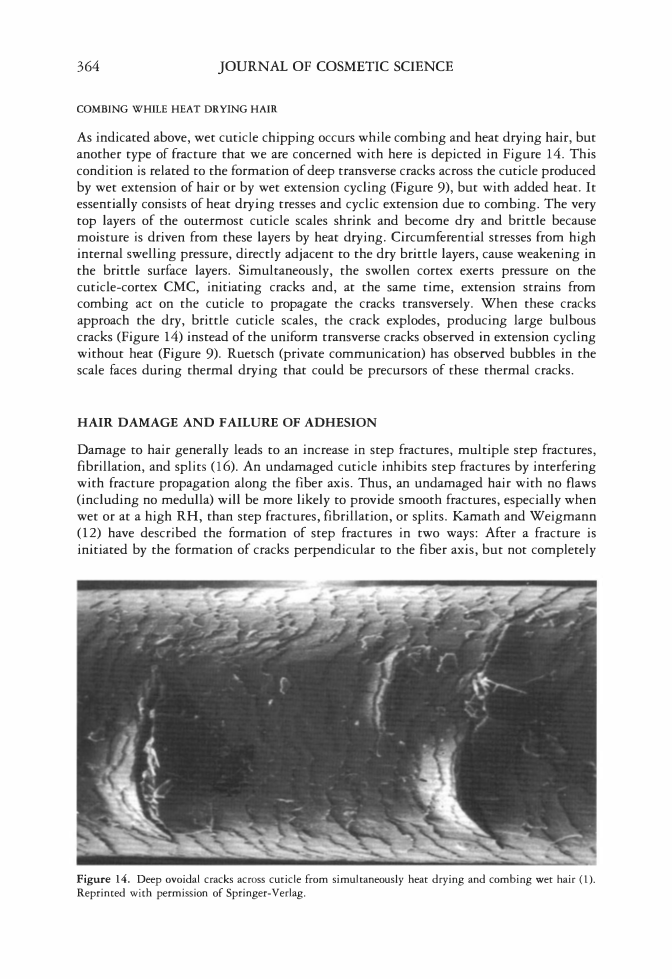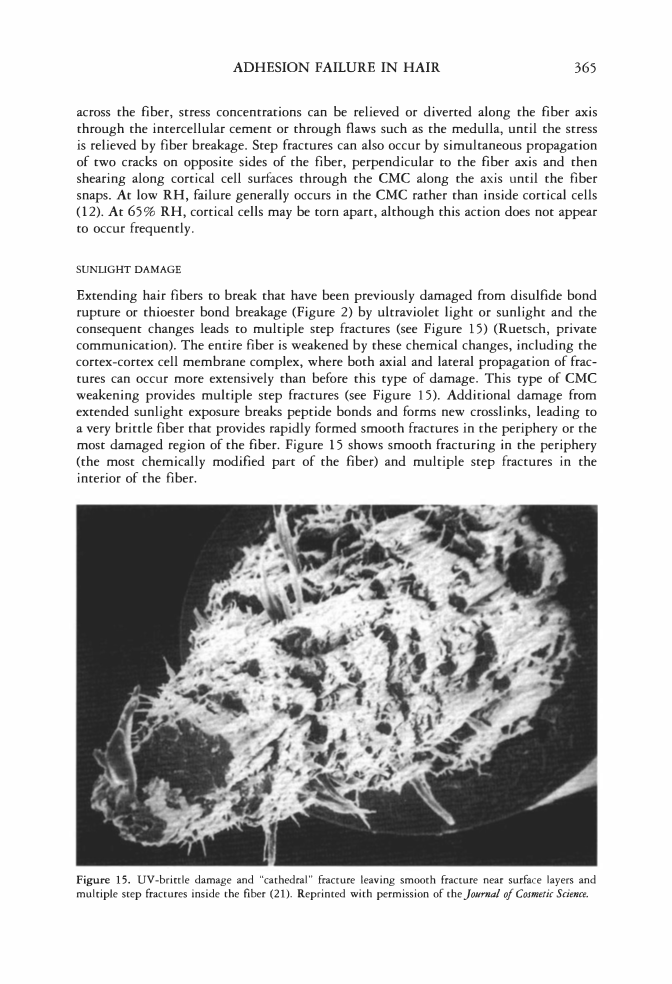364 JOURNAL OF COSMETIC SCIENCE COMBING WHILE HEAT DRYING HAIR As indicated above, wet cuticle chipping occurs while combing and heat drying hair, but another type of fracture that we are concerned with here is depicted in Figure 14. This condition is related to the formation of deep transverse cracks across the cuticle produced by wet extension of hair or by wet extension cycling (Figure 9), but with added heat. It essentially consists of heat d ry ing tresses and cyclic extension due to combing. The ve ry top layers of the outermost cuticle scales shrink and become dry and brittle because moisture is driven from these layers by heat d ry ing. Circumferential stresses from high internal swelling pressure, directly adjacent to the d ry brittle layers, cause weakening in the brittle surface layers. Simultaneously, the swollen cortex exerts pressure on the cuticle-cortex CMC, initiating cracks and, at the same time, extension strains from combing act on the cuticle to propagate the cracks transversely. When these cracks approach the dry, brittle cuticle scales, the crack explodes, producing large bulbous cracks (Figure 14) instead of the uniform transverse cracks observed in extension cycling without heat (Figure 9). Ruetsch (private communication) has observed bubbles in the scale faces during thermal drying that could be precursors of these thermal cracks. HAIR DAMAGE AND FAILURE OF ADHESION Damage to hair generally leads to an increase in step fractures, multiple step fractures, fibrillation, and splits (16). An undamaged cuticle inhibits step fractures by interfering with fracture propagation along the fiber axis. Thus, an undamaged hair with no flaws (including no medulla) will be more likely to provide smooth fractures, especially when wet or at a high RH, than step fractures, fibrillation, or splits. Karnath and Weigmann (12) have described the formation of step fractures in two ways: After a fracture is initiated by the formation of cracks perpendicular to the fiber axis, but not completely Figure 14. Deep ovoidal cracks across cuticle from simultaneously heat drying and combing wet hair (1). Reprinted with permission of Springer-Verlag.
ADHESION FAILURE IN HAIR 365 across the fiber, stress concentrations can be relieved or diverted along the fiber axis through the intercellular cement or through flaws such as the medulla, until the stress is relieved by fiber breakage. Step fractures can also occur by simultaneous propagation of two cracks on opposite sides of the fiber, perpendicular to the fiber axis and then shearing along cortical cell surfaces through the CMC along the axis until the fiber snaps. At low RH, failure generally occurs in the CMC rather than inside cortical cells (12). At 65% RH, cortical cells may be torn apart, although this action does not appear to occur frequently. SUNLIGHT DAMAGE Extending hair fibers to break that have been previously damaged from disulfide bond rupture or thioester bond breakage (Figure 2) by ultraviolet light or sunlight and the consequent changes leads to multiple step fractures (see Figure 15) (Ruetsch, private communication). The entire fiber is weakened by these chemical changes, including the cortex-cortex cell membrane complex, where both axial and lateral propagation of frac tures can occur more extensively than before this type of damage. This type of CMC weakening provides multiple step fractures (see Figure 15). Additional damage from extended sunlight exposure breaks peptide bonds and forms new crosslinks, leading to a very brittle fiber that provides rapidly formed smooth fractures in the periphery or the most damaged region of the fiber. Figure 15 shows smooth fracturing in the periphery (the most chemically modified part of the fiber) and multiple step fractures in the interior of the fiber. Figure 15. UV-brittle damage and "cathedral" fracture leaving smooth fracture near surface layers and multiple step fractures inside the fiber (21). Reprinted with permission of the Journal of Cosmetic Science.
Purchased for the exclusive use of nofirst nolast (unknown) From: SCC Media Library & Resource Center (library.scconline.org)






































































































